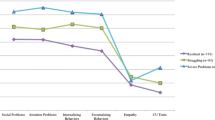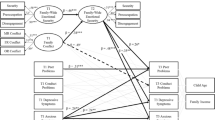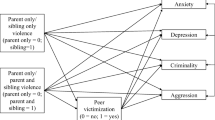Abstract
The present study examined the effects of different types of domestic violence (i.e., being a victim of parent-child violence and witnessing interparental violence) on adolescent adjustment. The sample included a large, racially/ethnically and socioeconomically diverse group of high school students. Findings revealed that this sample experienced and witnessed high levels of family violence. Two hierarchical regression analyses were conducted with externalizing behavior problem and internalizing behavior problem scores as the outcome variables. Variables were entered in three blocks with numerous sociodemographic variables entered first as covariates, the amounts of parent-child violence and witnessing interparental violence entered in the second block, and the interaction of gender and violence variables and interaction of the two violence variables in the third. Results revealed the amounts of parent-child violence and interparental violence witnessed were significant predictors of both externalizing and internalizing behavior problems. Significant effects were also found for the interaction between parent-child violence and interparental violence. The implications of the findings are discussed.
Similar content being viewed by others
References
Achenbach, T. M. (1991).Manual for the Youth Self-Report and 1991 Profile. Burlington, VT: University of Vermont Department of Psychiatry.
Asbury, J. (1993). Violence in families of color in the United States. In R. Hampton, T. P. Gullotts, G. Adams, E. H. Potter, & R. P. Weissberg (Eds.),Family Violence: Prevention and treatment, Newbury Park, CA: Sage Publications.
Bandura, A. (1977).Social learning theory. Englewood Cliffs, New Jersey: Prentice Hall.
Carlson, B. E. (1984). Children's observations of interparental violence. In A. R. Roberts (Ed.),Battered women and their families: Intervention strategies and treatment programs. New York: Springer.
Carlson, B. E. (1990). Outcomes of physical abuse and observation of marital violence among adolescents in placement.Journal of Interpersonal Violence, 6, 526–534.
Christopoulos, C., Cohn, D. A., Shaw, D. S., Joyce, S., Sullivan-Hanson, J., Kraft, S. P., & Emery, R. E. (1987). Children of abused women I: Adjustment at time of shelter residence.Journal of Marriage and the Family, 49: 611–619.
Emery, R. E., Draft, S. P., Joyce, S., & Shaw, D. (1986). Children of abused women: Adjustment at 4 months following shelter residence. Paper presented at the 94th Annual Convention of the American Psychological Association, Washington, D. C.
Fantuzzo, J. W., DePaola, L.M., Lambert, L., Martino, T., Anderson, G., & Sutton, S. (1991). Effects of interparental violence on the psychological adjustment and competencies of young children.Journal of Consulting and Clinical Psychology, 59, 258–265.
Garbarino, J., & Plantz, M. C. (1984). Child abuse and juvenile delinquency. What are the links? In J. Garbarino, C. Schellenbach, & J. Sebes (Eds.),Troubled youth, troubled families (pp. 27–39). New York: Aldine de Gruyter.
Gelles, R. J. & Hargreaves, E. F. (1990). Maternal employment and violence toward children. In M. A. Straus & R. J. Gelles (Eds.),Physical Violence in American Families: Risk Factors and Adaptation to Violence in 8,145 Families, pp. 507–526. New Brunswick, NJ: Transaction Publishers.
Grych, J. H., & Fincham, F. D. (1990). Marital conflict and children's adjustment: A cognitive-contextual framework.Psychological Bulletin, 108, 267–290.
Hollingshead, A. (1975).Four factor index of social position. New Haven, CT: Author.
Howing, P. T., Wodarski, J. S., Kurtz, P. D., Gaudin, J. M., Herbst, E. N. (1990). Child abuse and delinquency: The empirical and theoretical links.Social Work, 35, 244–249.
Hughes, H. M. (1988). Psychological and behavioral correlates of family violence in child witnesses and victims.American Journal of Orthopsychiatry, 58: 77–90.
Hughes, H. M., Parkinson, D., & Vargo, M. (1989). Witnessing spouse abuse and experiencing physical abuse: A “double whammy”.Journal of Family Violence, 4: 197–209.
Jaffe, P., Wolfe, D., & Wilson, S.K. (1990).Children of battered women. Newbury Park, CA: Sage Publications.
Jaffe, P., Wolfe, D. A., Wilson, S. K., & Zak, L. (1986). Family violence and child adjustment: A comparative analysis of girls' and boys' behavioral symptoms.American Journal of Psychiatry, 143: 74–77.
Jouriles, E., Barling, J. & O'Leary, K.D. (1987). Predicting child behavior problems in maritally violent families.Journal of Abnormal Child Psychology, 15: 165–173.
Jouriles, E., Murphy, C. M., & O'Leary, K. D. (1989). Interspousal aggression, marital discord, and child problems,Journal of Consulting and Clinical Psychology, 57, 453–455.
Kantor, G. K., & Straus, M. A. (1990). The “drunken bum” theory of wife beating. In M. A. Straus & R.J. Gelles, (eds.),Physical Violence in American Families: Risk Factors and Adaptation to Violence in 8,145 Families (pp 203–219). New Brunswick, NJ: Transaction Publishers.
Kashani, J. H., Daniel, A. E., Dandoy, A. C., & Holcomb, W. R. (1991). Family violence: Impact on children.Journal of the American Academy of Child and Adolescent Psychiatry, 32, 181–189.
Luthar, S. & Zigler, E. (1991). Vulnerability and competence: A review of research on resilience in childhood.American Journal of Orthopsychiatry, 61, 6–22.
Martin, J. A. & Elmer, E. (1992). Battered children grown up: A follow up study of individuals severely maltreated as children.Child Abuse & Neglect, 16, 75–87.
National Center On Child Abuse Prevention Research. (1994). Current Trends in Child Abuse Reporting and Fatalities: The Results of the 1993 Annual Fifty State Survey. Chicago, IL. National Committee to Prevent Child Abuse.
O'Keefe, M. (1993). Linking marital violence, mother-child/father-child aggression and child behavior problems.Journal of Family Violence 9, 63–78.
Rosenberg, M.L. & Mercy, J.A. (1991). Assaultive violence. In M.L. Rosenberg and M.A. Fenley (eds.),Violence in America, pp. 14–50. new York, Oxford University Press.
Spaccarelli, S., Sandler, I. N., & Roosa, M. (1994). History of spouse violence against mother: Correlated risks and unique effects in child mental health.Journal of Family Violence, 9, 70–98.
Sternberg, K.J., Lamb, M. E., Greenbaum, C., Cicchetti, D., Dawud, S., Cortes, R. M., Krispin, O., & Lorey, F. (1993). Effects of domestic violence on children's behavior problems and depression.Developmental Psychology, 29, 44–52.
Stewart, M. A. & duBois, C. S. (1981). Wife abuse among families attending a child psychiatry clinic.Journal of the American Academy of Child Psychiatry, 20: 845–862.
Straus, M. A. (1979). Measuring intrafamily conflict and violence. The conflict tactics (CT) scales.Journal of Marriage and the Family, 41, 75–86.
Straus, M. A., Gelles, R., & Steinmetz, S. (1980).Behind closed doors. Garden City, NJ: Anchor Books.
Straus, M. A. & Smith, C. (1990). Family patterns and primary prevention of family violence. In M. A. Straus & R. J. Gelles (eds.),Physical Violence in American Families: Risk Factors and Adaptation to Violence in 8,145 Families, pp. 507–526. New Brunswick, NJ: Transaction Publishers.
Wauchope, B. A. & Straus, M. A. (1990). Physical punishment and physical abuse of American children: Incidence rates by age, gender, and occupational class. In M. A. Straus & R. J. Gelles (eds.),Physical Violence in American Families: Risk Factors and Adaptation to Violence in 8,145 Families, pp. 133–148. New Brunswick, NJ: Transaction Publishers.
Widom, C. S. (1989). Does violence beget violence? A critical examination of the literature.Psychological Bulletin, 106(1), 3–28.
Wolfe, D. A., Jaffe, P., Wilson, S. K., & Zak, L. (1985). Children of battered women: The relation of child behavior to family violence and maternal stress.Journal of Consulting and Clinical Psychology, 53: 657–665.
Wolfner, G. D. & Gelles, R. J. (1993). A profile of violence toward children: A national study.Child Abuse & Neglect, 17, 197–212.
Zaslow, M., & Hayes, C. (1986). Sex differences in children's response to psychosocial stress: Toward a cross-cultural context analysis. In M. E. Lamb, A. L. Brown, & B. Rogoff (Eds.),Advances in developmental psychology, (pp. 285–338). Hillsdale, NJ: Erlbaum.
Author information
Authors and Affiliations
Rights and permissions
About this article
Cite this article
O'Keefe, M. The differential effects of family violence on adolescent adjustment. Child Adolesc Soc Work J 13, 51–68 (1996). https://doi.org/10.1007/BF01876595
Issue Date:
DOI: https://doi.org/10.1007/BF01876595




